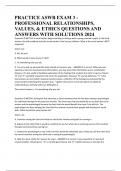Exam (elaborations)
PRACTICE ASWB EXAM 3 - PROFESSIONAL RELATIONSHIPS, VALUES, & ETHICS QUESTIONS AND ANSWERS WITH SOLUTIONS 2024
- Course
- Institution
PRACTICE ASWB EXAM 3 - PROFESSIONAL RELATIONSHIPS, VALUES, & ETHICS QUESTIONS AND ANSWERS WITH SOLUTIONS 2024
[Show more]



